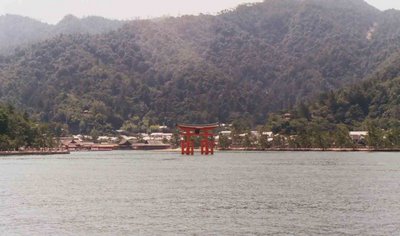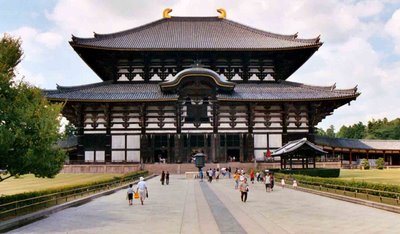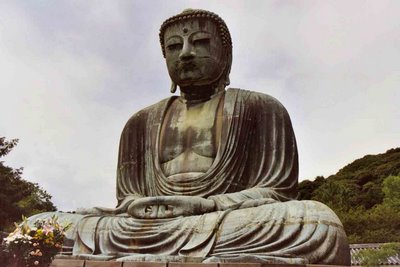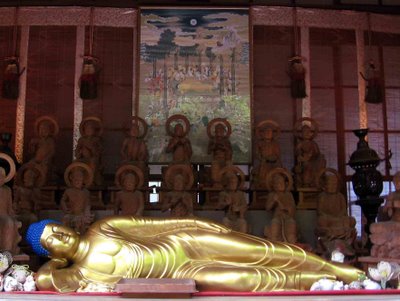It's not the heat.... it's Hachigatsu
I arrived August 17th, which was supposed to be pretty much the end of typhoon season. Sure enough, that night, while Alan and I were spending 1.5 hours in the subway coming back from the Arai's, it really stormed. That was pretty much it for rain while we were there, or at least substantial precipitation (there were some sprinkles, and some fog). But August, or Hachigatsu, is VERY HUMID. I have never sweated so much with so little exertion in my life. Folks there walked around with little cloths, about the size of a handerchief, that they used to wipe their faces and necks off. Alan bought us each one -- my very special souvenir. Alan, appropriately, called them "mops." Most days were in the 80's with, I swear, 90% humidity. I provide pictorial proof below. Obviously, I was the one wielding the camera.
Alan in front of the red god of thunder at the Taiyuin-byo shrine in Nikko. Notice his "mop" clutched in his right hand, and other signs of moisture.

This guy isn't sweating because he's the green god of wind. Also at Taiyuin-byo. Just wanted to show another god.

Okay, so it's not obvious that Alan's sweating in this picture, but believe me, he was. Why else is he standing in the shade, and see the ladies behind him with parsols!!! Alan's under the Noimon gate at Daisho-in Temple on Miyajima. The Dai-hannyakyo Sutra are behind him. These sutras are on individual 'scrolls' hanging from the inside handrail of the stairs.
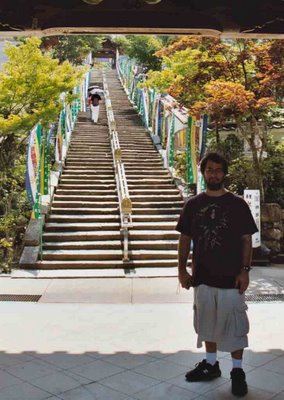 Touching all these sutras as you laboriously climb the stairs will bring enormous fortune. Alan and I are still waiting... (Baker)
Touching all these sutras as you laboriously climb the stairs will bring enormous fortune. Alan and I are still waiting... (Baker) This was the coolest night I was there, our second to last night, but you know these guys were sweating in those outfits. This was in Ikekuburo, Tokyo, on a Saturday night. Look at the kid's hand shaking! Clearly, he's terrified of these guys. Well, maybe not. I believe they're characters from a game or something else equally unknown to someone my age.
This was the coolest night I was there, our second to last night, but you know these guys were sweating in those outfits. This was in Ikekuburo, Tokyo, on a Saturday night. Look at the kid's hand shaking! Clearly, he's terrified of these guys. Well, maybe not. I believe they're characters from a game or something else equally unknown to someone my age. Minutes after I had surreptitiously used my mop to wipe down my stomach and back, I saw these two traffic cops. Standing out in the blazing sun, with their long sleeve shirts, pants, and gloves, guiding relatively low volume traffic. I noticed that uniforms are taken much more seriously in Japan than in the US. If you wore a uniform in Japan, it was a sharp one. No concessions for comfort or modernizing of style. There was no mistaking the officials at the train stations, on the trains, police officers, the "bike" patrollers (making sure bikes were parked correctly in Kyoto--I think), etc.
Minutes after I had surreptitiously used my mop to wipe down my stomach and back, I saw these two traffic cops. Standing out in the blazing sun, with their long sleeve shirts, pants, and gloves, guiding relatively low volume traffic. I noticed that uniforms are taken much more seriously in Japan than in the US. If you wore a uniform in Japan, it was a sharp one. No concessions for comfort or modernizing of style. There was no mistaking the officials at the train stations, on the trains, police officers, the "bike" patrollers (making sure bikes were parked correctly in Kyoto--I think), etc. What is Alan doing? Is he washing money in a spring in a cave with the chance of its doubling in value? Yes, he is! This is the shrine to the goddess Zeniarai Benton, which we went to on our way to the Daibutsu in Kamakura (the big buddha outside). Supposedly if you wash your money in this spring, it will double, although not immediately my guide book says. Again, Alan and I are still waiting. Little baskets are supplied so you can safely dunk your yen (bills too). This place was also really smoky, as the incense burned was in big bundles of 10 sticks or so, instead of the usual 1 or 2 sticks. I don't understand the significance of that. This was not even one of the hottest days, maybe only 80 degrees...
What is Alan doing? Is he washing money in a spring in a cave with the chance of its doubling in value? Yes, he is! This is the shrine to the goddess Zeniarai Benton, which we went to on our way to the Daibutsu in Kamakura (the big buddha outside). Supposedly if you wash your money in this spring, it will double, although not immediately my guide book says. Again, Alan and I are still waiting. Little baskets are supplied so you can safely dunk your yen (bills too). This place was also really smoky, as the incense burned was in big bundles of 10 sticks or so, instead of the usual 1 or 2 sticks. I don't understand the significance of that. This was not even one of the hottest days, maybe only 80 degrees...






